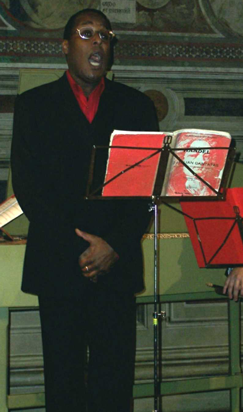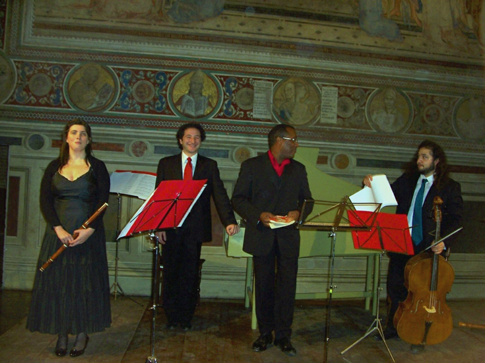04 Dec 2007
Beyond The Media Avatar
Imagine a mild December night, with some three hundred people queueing for a concert ticket on Siena’s horseshoe-shaped Piazza del Campo.

Imagine a mild December night, with some three hundred people queueing for a concert ticket on Siena’s horseshoe-shaped Piazza del Campo.
Past the stately gates of the medieval city hall, a breath-taking sight: the Sala del Mappamondo, a large hall studded with the old regalia of the proud Tuscan Republic that once competed with Florence over supremacy of Europe’s financial markets. Images of saints and sinners; angels, bankers, friars and warriors frescoed by Simone Martini, Duccio di Buoninsegna, Sano di Pietro — names echoing like clarions. And the clarions are actually there, arranged within crystal shelves: precious originals of the long trumpets whose copies still resound twice in a year for the Palio horse race. From Autumn 2008, this is planned to become one more regular series, a so-called “Festival Contemporaneamente Barocco” storming a variety of historic venues in the city — including two recently-restored opera houses, the cathedral, the university and more — with events connected to opera, music, drama and cultural heritage at large.
To Italian concertgoers who missed the seldom chance to hear him live, countertenor Derek Lee Ragin is a sort of media avatar, the lower half of Farinelli’s voice as heard in the gorgeous soundtrack of a (quite despicable) 1994 feature film on the legendary Neapolitan castrato. The upper one, as largely spread at that time, was provided by the Polish soprano Ewa Mallas Godlewska, with a French computer digitally processing both halves into the virtual reconstruction of a voice which, around 1725, could boast a range of two octaves and a fourth (from A to D’’’) — and later extended by a few more pitches downward, thus to around three octaves! (However, there is no surviving evidence in the scores that Farinelli ever used all of them in any single piece…).

As to Ragin, his voice sounds most effectively in the range just around the middle C up to a tenth above. It might have grown darker in years, yet without losing the appeal of an other-wordly color, something of an alto of warm polish and purity, all of a sudden opening up towards high notes generally forbidden to the male falsetto. At those dizzying pitches, he doesn’t either squeak or resort to a metallic compression that betrays strain, like many among his peers tend to, but emerges with a lustrous full-pressure resonance, apparently with some major support from the chest. If only he could smooth the transition between both ranges, you would call him a monster; nevertheless, he remains a singer of superior class and versatility, equally at ease in Baroque arias, contemporary music and the Negro spiritual. Add to that a technical refinement matching the stipulations of early Bel Canto style. His opening messa di voce in “Alto Giove”, from Porpora’s Polifemo, pierced the gloomy instrumental atmosphere like a sunbeam from a cloudy sky — a terrific effect. One more piece from Farinelli’s suitcase repertoire — “Ombra fedele anch’io”, set by the castrato’s profligate brother Riccardo Broschi in his opera Idaspe — was lamentably shortened of its second section and subsequent da capo. A pity indeed, considered Ragin’s heart-rending delivery of the first plaintive section, featuring a good deal of appoggiaturas and inter-registral leaps in slow tempo. Before that, a pair of Handel cantatas (Mi palpita il cor, HWV 132d and Lungi da me, HWV125b) displayed bravery in fast syllabic passages, meaningful switching between staccato and legato, polished fast trills, evidence of dramatic sensitivity in the recitatives. By the way, Ragin’s Italian diction was more than acceptable throughout, reaching a peak in the favorite encore “Ombra mai fu” from Xerxes, whose notorious text clumsiness often fires jokes among native hearers.

Besides providing a spirited accompaniment to Ragin’s vocal solos, the resident period band “Il Rossignolo” (a gentle archaism for nightingale) showed off with notable panache in the fillers: a four-parts sonata and a concerto for the same forces by Telemann, plus Vivaldi’s Concerto for recorder, RV 106. All of the players emerged in turns for their individual merits and deserve quotation: harpsichordist-cum-conductor Ottaviano Tenerani and flautist Marica Testi for their assured elegance of phrasing, the mercurial cellist Ludovico Minasi for his bold strokes, Luca Giardini, a young violinist in growing international demand, both for finery of sound and fanciful embellishments. Oboist Martino Noferi, a promising virtuoso on the baroque oboe, didn’t perform equally well on the recorder. He should probably choose for the better opportunity, sooner or later.
Carlo Vitali